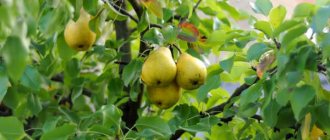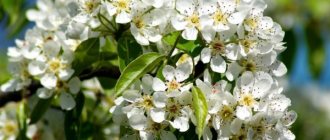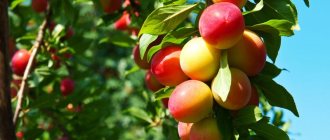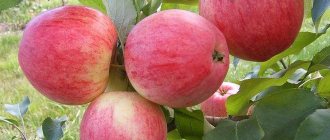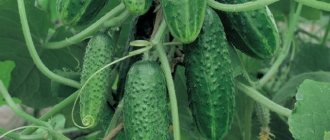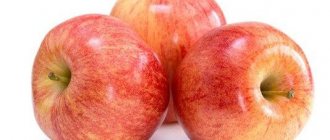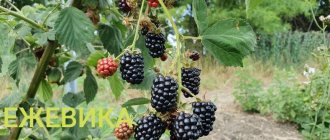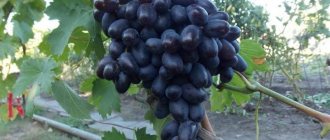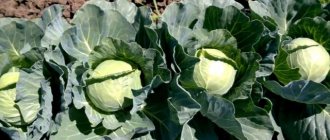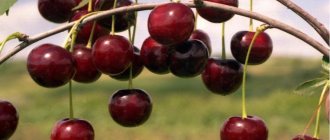History of appearance
Hungarian is a group of plums that includes dozens of varieties. Plums with oblong dark bluish plums came to Europe from Asia. The source of prunes began its triumphal march across the European continent from the territory of the Balkans. The variety appeared on the territory of Russia at the beginning of the 20th century.
In Hungary, this plum has been cultivated for a long time - it was the Hungarians who invented the original method of harvesting. They didn’t pick the plums - they just waited for them to ripen, wilt and fall down. Dried plums acquired a special taste and did not spoil for a long time.
There are a lot of plum trees in Hungary; they grow everywhere. They say that parishioners who came to the priest for repentance received a plum seedling from him. So all the roadsides were planted with plum trees.
Hungarian plum: variety description
Hungarian plum: photo of variety
One of the composition of crops with a number of varieties of characteristics. Most breeders are very pleased with the appearance of this variety. the fruit tolerates diseases and frosts, and also has high taste, and it is from this variety that excellent prunes are obtained.
The Hungarian plum variety is a certain composition of the fruit, which consists of a large number of species. A variety from Asia was released into the European part. It all started in the Balkan region. On Russian soil, culture was studied at the beginning of the twentieth century.
Hungary - discovered the ideal way to harvest. The fruits were picked without tearing them off; the plums fell off on their own when they were ripe. At this time they are wilting. Namely, these fruits have a good taste and can last a long time after harvest.
Hungary is a country of plum trees, and it is their territories that are overgrown with this variety. People who come to church to repent receive a plum tree shrub from the priest. In this country, plum trees grow on all roadsides.
Description and characteristics of the varietal group
Features of the Hungarian plum:
- Tree height is 5-6 m. The crown is oval or elongated pyramidal. The shoots are reddish in color and fast growing. If desired, the crown can be shaped so that the height of the tree does not exceed 3-4 m.
- Average frost resistance - Hungarians are contraindicated in regions with harsh winters. Plus - the tree quickly regenerates after freezing.
- Drought resistance - trees are able to produce large yields even in the absence of watering.
- Most are self-fertile - they do not need pollinators.
- Good immunity - varieties are resistant to most viral and fungal diseases of fruit crops.
- Stable yield – without interruptions.
- Productive life span is 30 years.
- The trees produce a lot of root growth - this must be taken into account when choosing a site and neighbors for the Hungarian.
- Flowering later - harvest time depends on the specific variety.
- The branches need support - due to the abundance of plums, they break off.
- Ripe plums remain on the branches for a long time - they do not rot or fall off, maintaining excellent commercial qualities.
The Hungarian has one drawback, but gardeners easily forgive the Hungarian for it - against the background of its advantages, its lack of precocity pales. Many old Hungarian varieties begin to bear fruit only 6-8 years after planting the seedling. For the most impatient gardeners, breeders have developed new varieties that begin to bear fruit in the 3-4th year of planting.
It has been noticed that the larger the Hungarian fruits, the higher the likelihood of damage to the tree by diseases and pests.
Hungarian plum: characteristic features of the variety
Plum Hungarian: photo
The plum tree of the Hungarian variety is tall, its size reaches from five to six meters. The crown is rounded, trapezoidal in shape. The branches are brown in color and tall. The crown can also be cut to such an extent that the tree can grow no higher than three or four meters. This variety tolerates winters, but not severe ones; this variety is not grown in the north. It takes a short amount of time to restore a tree after winter.
The Hungarian plum easily tolerates drought and can produce a large amount of harvest, even in dry weather. Culture refers to independent fruiting. It is not necessary to plant crops in the neighborhood. The variety has a wonderful immune system, tolerates diseases, as well as rodents that infect the plant.
High yield. The Hungarian plum variety is a perennial and lives up to thirty years. A tree can develop a large amount of overgrowth, so cut off excess grass and also look at the plants in your neighborhood, they can only increase the growth of overgrowth.
The vegetation blooms late, harvest depends on the variety. It is necessary to place a support so that the branches do not break due to the large weight of the fruit. Make sure that there are ripening plums on the branches; overripe fruits that have not fallen can rot right on the shoots. Thus they will lose their attractiveness.
Of the minuses, we can only say about the slow early ripening of the Vengerka plum. Most species can bear fruit only in the sixth or eighth year after planting. If gardeners rush vegetation for fruiting, but scientists have already succeeded in this and have discovered a variety that produces fruit already in the third or fourth year after planting a Vengerka plum seedling.
By the fruits you can determine whether the tree is affected by pests, diseases or not; if the fruit has become much larger, then it is worth carrying out preventive work on your tree.
Hungarian plums: pollinating varieties
Even in this case, you can plant neighboring plants nearby for pollination. Neighboring crops should bloom together with Hungarian. In most cases, garden plums are planted. It is forbidden to grow bushes with berry crops; they interfere with the development of the Vengerka plum seedling.
Popular varieties of Hungarian
Hungarian varieties are divided into:
- Dining rooms. They are popular among amateur gardeners and have good taste.
- Technical. Used in industrial gardening. Productive and unpretentious.
Korneevskaya
A self-fertile, productive variety of domestic selection, named after the breeder - the creator of the hybrid. Pollinators are recommended to increase yields. Trees 4 m high, with a spreading or pyramidal crown. Collection – 30 kg of plums. Annuals produce a harvest 4 years after planting. The lifespan is determined by the rootstock. It bears fruit for about 15 years. Harvesting is from the end of August to the second half of September.
The fruits are blue, with a brownish tint. Juicy, with honey-colored flesh. The bone is small. Fruit weight is 30-35 g. Branches need support during fruiting. Fruits with a dessert taste, suitable for any processing. They tolerate transportation well.
Winter hardiness is high; the tree has a thick bark that protects it from low temperatures. Part of the buds freezes out during severe frosts and sudden temperature changes. Insufficient resistance to certain diseases.
Pulkovskaya
Late-ripening, partially self-fertile variety. The tree grows up to 3-4 m, with a wide spreading crown. Bears fruit after 3 years. Harvest per tree – 25 kg. The fruits ripen late and unevenly - they are harvested in stages throughout September. The lifespan of a tree is 20-25 years.
The fruits are small, asymmetrical, weigh 20-25 g. The skin is dark red, the flesh is yellow. Plums are good for home consumption. The taste is not ideal. The variety is distinguished by high winter hardiness. Plus, the fruits hang for a long time without falling off. The variety is resistant to aphids. The downside is that the skin cracks in wet weather. Pulkovskaya is demanding on soils - it prefers fertile loams.
Voronezh
This self-sterile late-ripening variety was created for the southern regions. The height of the tree is 3-4.5 m. The crown is oval, formed by branches directed upward. The pollinator can be any plum variety that is suitable for flowering time - Persikovaya, Zyuzinskaya, Michurinskaya, etc.
Harvest per tree – 30 kg. Weight - 40 g. Shape - curved, pear-shaped. The skin is purple, turning into a brown tint. The greenish pulp, with a consistency reminiscent of an olive, has a very pleasant taste and aroma. The fruits are eaten fresh and canned.
Pros: high immunity and quick recovery after freezing. Disadvantages: long growing season and low frost resistance. If the summer is cool, the fruits may not ripen. Then they are removed unripe and sent for ripening.
Dubovskaya
This late variety is not often found in Russian gardens. The trees are vigorous, with high rounded crowns. It is mainly concentrated in the place of its breeding - in the southern regions. It begins to bear fruit by the fifth year. Harvest in September. Productivity up to 30 kg.
The fruits are medium-sized, dark purple, covered with a bluish waxy coating. They weigh 25-30 g. The fruits are sweet and sour. The seeds are difficult to separate from the pulp. The variety has high immunity and is very resistant to moniliosis and codling moth. Well stored and transported over long distances.
Michurinskaya
Self-fertile variety. One tree produces up to 25 kg. The fruits weigh 30 g. Purple plums are covered with a bluish coating. The pulp is sugary, green, loose. The taste is excellent, the sourness is insignificant. The bone is small. The fruits, remaining on the branches for a long time, retain their presentation and taste.
It tolerates frost well and is transported without loss. The variety is used by the food industry - it is used to produce baby food. The downside is that it is difficult to remove the seeds.
Azhanskaya
The variety was bred in France. Tree 4-4.5 m high. The crown is crushed. The crop begins to bear fruit at 4-5 years. Up to 70 kg are collected from a tree. Mass ripening - the last ten days of August. The variety is considered self-fertile, but pollinators are recommended - Renclod Green or Renclod Altana.
The fruits are large, thick-skinned, purple-red. The pulp is slightly fibrous, amber in color, with a greenish tint. Juicy fruits with excellent taste and slight sourness. Weight – 15-25 g. Ripe plums hang on the branches for a long time and do not fall off.
The downside is that the fruits crack in rainy weather. After fruit cracking, fungal diseases may occur. The most dangerous pest is the almond seed eater. Winter hardiness is low, so the variety is grown only in the southern regions.
Donetsk
Self-fertile plum, bred by Donetsk breeders. The trees are medium-sized, up to 4.5 m high, spreading. They bear fruit 4-5 years after planting. Annual collection – 30 kg. Pollinators are planted for productivity. More suitable than others are Anna Shpet, Italian, Renklod Altana.
The fruits weigh approximately 30 g. The color is dark purple, with a brown tint. Covered with a thick coating. The flesh is olive-colored, sweet and juicy, slightly sour. The fruits are used to make prunes and good compotes. The fruits are stored for about 3 weeks. In a cool room or refrigerator - even longer.
The variety requires special soils. Does not tolerate dry sandy soils; fertile loams are needed. The fruits are well transported. Lifespan is up to 20 years.
There are two versions of the Donetsk Hungarian variety - early and late. They differ not only in terms of ripening, but also in the taste of the fruit.
Amazing
Requires pollinators. Tree height - 4.5 m. First harvest - in 4-5 years. The yield per tree is average - 25-30 kg of plums.
The fruits are medium-sized, drop-shaped, dark blue, with yellow flesh. Covered with a blue waxy coating. Weight – 25-30 g. The seeds are difficult to remove from the sugary pulp. The variety is resistant to fruit rot. Thanks to its high frost resistance, the variety has become popular in the Urals.
Bogatyrskaya
An early ripening variety with excellent yield. The fruits ripen in mid-August. 80-120 kg of plums are collected from one tree. The trees are medium-sized with spreading crowns, height – 4 m. Life expectancy – 30 years. Fruits in 4-5 years.
The fruits are large, sweet and sour, with a honey taste. They weigh from 30 to 60 g. The skin is dark purple, almost black, with a whitish coating. The pulp is light green. Has excellent agrotechnical characteristics. Plums of this variety are well transported. Minus - the bone is difficult to separate from the pulp.
Italian
Late ripening. The tree is medium-sized, with a spherical crown. Plums ripen in mid-September. Productivity – 70-80 kg per tree. To increase productivity, pollinators are recommended - plum varieties Altana, Renklod green, Azhanskaya. The first harvest is in the 4th year of planting.
The fruits weigh 30-35 g. The skin is black-violet, covered with a bluish-whitish coating. The flesh is green-yellow, denser near the seed. The pulp has a weak aroma. The variety is resistant to fungal diseases and codling moth. It does not tolerate drought - the tree immediately loses its ovaries.
The variety is recommended for southern regions; even in temperate climates, trees often freeze.
Ordinary
Popular variety. The trees are tall - up to 6 m. The crowns are pyramidal in shape, the branches are spreading. The lifespan of a tree is 30 years. Fruiting occurs only in 5-6 years. A very productive variety - 150-180 kg per tree. The variety is self-fertile, but pollinators are desirable.
The fruits are small, weight – 20 g. Skin color – dark purple, to black. The pulp is sweet and sour. The variety is demanding when it comes to watering - it loves moist soil and is resistant to diseases. The fruits tolerate transportation well and are stored for up to 25 days. The variety is not suitable for regions with harsh climates.
Belarusian
Large-fruited variety. The trees are medium-sized, up to 3.5 m high. The crowns are spreading, of medium density. It begins to bear fruit at 3-4 years. The variety is partially self-fertile. The fruits ripen in early September. Productivity – 30 kg.
The fruits are elongated, weigh about 40 g. The skin color is purple. The pulp is orange in color, with a sweet and sour taste. The variety tolerates low temperatures well, is resistant to fungal diseases, and is consistently productive. Plums are well stored and transported.
Moscow
The variety is self-fertile, bred in the 50s. last century. The height of the tree is 3-3.5 m. The crown is dense, spherical. The first harvest is for 7-8 years. Up to 40 kg are collected from a tree. Ripening – early to mid-September.
The fruits are asymmetrical, purple, weigh 20-30 g. The shape is ovoid, elongated. The pulp is juicy, amber. The seeds are easily separated from the pulp. The variety is inferior to new varieties - it has medium-sized fruits, but their taste is mediocre, fruiting is delayed. The variety is widely used in amateur and industrial gardening.
Plum Vengerka: reviews
Elena Serenko
Our parents from Anapa allocated a Vengerka plum seedling to us. We planted a seedling. At first everything was great. But a cold winter came, the tree froze and died. It's a pity that it can't take root in our area. But the fruits are very tasty. From the Hungarian variety, we planted Voronezhskaya, it is more resistant to frost.
Petr Filatov
I grow only the Moscow plum variety from the Hungarian plum variety. The fruits that grow taste sour, and it is not an option to eat them in this form. But my wife makes jam or preserves, and they turn out very tasty. Our harvest is in early autumn. The variety is resistant to winter; in our region, such a tree is simply a miracle.
Fruit characteristics and yield
The fruits of the Hungarian have common features characteristic of all varieties of this group:
- Form. The fruits are oblong, asymmetrical, pointed at the edges.
- Color. The skin is lilac or violet. There are varieties with greenish fruits. There is a waxy coating. The pulp is yellowish in color, dense, tasty, juicy, with an excellent aroma.
- Weight and size . The fruits are large, reaching 6 cm in length and 4-5 cm in width.
- Bone . Small in size, oblong. Easily separates from the pulp. The fruits are easily broken into halves along the “seam”.
- Transportability. The fruits tolerate transportation well. They do not leak or release juice during transportation.
- Keeping quality. The fruits do not spoil for a long time, especially in a cool place. Collected unripe, the fruits do not spoil, but safely “reach” the condition. Shelf life – 3-4 weeks.
- Productivity. Depends on the variety, but on average it is 30 kg per tree. Maximum yield – 150 kg.
- Compound. It differs from other varieties in its high sugar content - 15%, and dense pulp, with 20% dry matter. You can get prunes from the fruits of the Hungarian plum - no other types of plums are suitable for this purpose.
Hungarian fruits well in regions with a temperate climate. Due to its high yield and transportation, Hungarian is ideal for profit.
The timing of fruit ripening varies depending on the variety. In general, the harvesting range lasts from late August to October. Most Hungarian varieties belong to the groups of medium and late ripening.
Hungarian Belarusian
We recommend reading our other articles
- Quail brooder
- The most common diseases of cucumbers
- Pavlovsk breed of chickens
- How to get rid of wireworm?
Photo of Hungarian Belorusskaya plum
The description of the Belorussian Hungarian variety should begin with the characteristics of the tree. It grows up to 3.5 meters. The crown is round, not thickened, with wide, sparse branches. Fruiting is observed from 3 years. The tree is partially self-fertile, the annual yield is up to 30 kg, but when planted near the Cromagne or Bluefree varieties, it can increase significantly.
Interesting!
Belarusian Hungarian was obtained by Belarusian scientists in 2009. So this is a relatively young species.
The cream is ready for collection in the second half of August. The fruits weigh 40 g and are ovoid in shape. The color of the skin is blue with a pronounced coating. The pulp after full ripening is orange and elastic. The taste is sweet and sour. Belarusian Hungarian is universally used; it can be used for processing and for fresh consumption.
The variety is frost-resistant, so it is grown in areas with a cool climate. Immunity is average, and this crop does not suffer from diseases such as clasterosporiasis at all with normal care.
Preparing and planting the Hungarian
The time for planting the Hungarian plum is selected taking into account the climatic characteristics of the region. In the southern area, it is recommended to plant Hungarian in the fall - at the end of September. In regions with a temperate climate, it is better not to take risks and plant seedlings in April, before sap flow begins. Before planting seedlings in a permanent place, gardeners prepare the soil in advance.
Selecting a location
What to look for when choosing a site for planting Hungarian grass:
- Illumination. The Hungarian is thermophilic, so the warmest and sunniest place is chosen for it. The ideal place for plums is a sunny area in the southern or southwestern part of the garden. Definitely on a hill, but with protection from strong winds.
- The soil. The best soil option is slightly alkaline. If necessary, soil characteristics are improved. Groundwater should not approach the surface closer than 1.5 m.
- Humidity. Due to excessive dampness, the bark, especially in the area of the root collar, begins to warm up. Therefore, lowlands are excluded - they are damp, fog collects, humidity persists for a long time after rains, snowdrifts are created in winter - all this is contraindicated for a Hungarian.
- Neighborhood with trees. Hungarian is planted no closer than 3 m from other trees.
Soil requirements and soil preparation
Hungarian needs sandy or loamy soils. Plums do not grow in acidic soils. To reduce the acidity of the soil, add 600 g of wood ash or dolomite flour. Plum does not like dry sandstones - on such soils its ovaries often fall off and productivity decreases.
Do not add lime to the planting hole - it can burn the roots of the seedling. If liming of the soil is necessary, it is carried out long before planting - while digging the soil. Lime norm per 1 sq. m – 800 g.
In order for the Hungarian to quickly take root and develop quickly, favorable conditions are created for it in advance - the soil is prepared. All weeds are removed from the area intended for planting and carefully dug up, adding compost during digging.
Selection and preparation of planting material
A well-chosen seedling is the key to a good start. Damaged or diseased planting material is usually found in markets, so it is better to take seedlings from special nurseries.
Requirements for a plum seedling:
- age – 1-2 years;
- the root system is fresh, not overdried;
- bark without damage;
- the stem is even, without splits;
- rootstock – dwarf or semi-dwarf;
- absence of dry branches or rotten roots;
- parameters for the first grade – height from 1.4 m, diameter – from 1.3 cm;
- parameters for the second grade – height from 1.1 m, diameter – from 1.1 cm;
- for branched trunks, the height is from 0.5 m, the diameter is from 1.4 cm, the length of the branches is from 20 cm;
- no damage, signs of disease, lichen, broken or cut branches.
It is advisable to purchase seedlings in plastic containers with fertilized substrate. This option allows you to replant the tree without stress, without damaging the root system. The seedling is taken out of the container and, together with a lump of earth, placed in the hole.
If the seedling is purchased without a container, then its roots are moistened and evenly distributed over a mound of soil mixture poured into the hole.
Landing
A seedling is planted in the fall or in the spring - the process is approximately the same. Unless, if desired, the hole can be prepared for spring planting in the fall. The process of planting a Hungarian seedling:
- The planting hole is prepared approximately 2 weeks before planting the seedling. The procedure for preparing the pit:
- Dig a hole 60-70 cm wide and 50-60 cm deep.
- A peg is driven into the center of the hole - 20 cm deep into the soil.
- The prepared soil mixture is poured into the hole - it should occupy 2/3 of its volume. To prepare the soil mixture, take a fertile layer of soil, mix it in a 1:1 ratio with humus, add ammonium nitrate (100-200 g), potassium chloride (200-300 g) and superphosphate (500 g). It is advisable to introduce river sand and gravel into the soil mixture to create drainage and increase the heat capacity of the soil.
- Place the seedling on a mound of soil mixture, spreading its roots evenly - they should not twist or bend upward.
- The hole is filled with fertile soil, watered and sprinkled with mulch - sawdust or peat.
Hungarian plum: planting varieties
It is worth planting the Hungarian plum in good weather; in the south, for example, it is planted in mid-autumn. In the middle zone in mid-spring. Do not forget that the soil for the crop must be ready at the time of planting.
How to choose the right place to land?
In order for the Hungarian Plum to quickly take root, you need to know some criteria when planting:
- Light - a large amount of light is needed, as well as heat. The place should be open under the sun; you can plant a Vengerka plum seedling in the south or southwest of the site. Do not plant in lowlands or in places where there are strong gusts of wind.
- ideal soil If the soil is weak, it is fed with nutrients. There should be no groundwater in the pit; it should be at a distance of at least one hundred and fifty centimeters.
- Moisture - when a large amount of moisture accumulates, the neck of the roots begins to rot. Thus, it cannot be planted below. There is dampness, fog, accumulation of water after rains, snow accumulation in winter.
- Neighboring crops - recommends planting crops at a distance of about three meters from neighboring crops.
Choosing the right soil
The ideal soil is gerbil or loam. This variety will not develop in acidic soils. But if you have no other option, then you can add about six hundred grams of wood ash to the soil, and you can also use dolomite flour. Also, the crop does not tolerate drought, so monitor soil moisture. Otherwise, the ovaries may fall off, thus reducing the amount of harvest.
There is no need to fill the planting hole with lime; it can damage the roots of the Vengerka plum seedling. They get rid of acid in the soil long before planting, when they hill up the soil. Lime can be used in quantities of eight hundred grams per square meter.
To quickly adapt, it is necessary to prepare the land in advance. Thus, weeds are removed from the planting site, hilled up and manure is applied to the soil.
How to care for a Hungarian?
Care for all varieties of Hungarian is the same. The tree requires watering, pruning and other standard agrotechnical measures.
Watering
Plum is a moisture-loving crop, but one of the main advantages of Hungarian plum is its high drought resistance. There are varieties of Hungarians that can safely bear fruit in the most severe drought. But these are extreme conditions that exhaust the plant. Therefore, a careful gardener must water the plum tree in a timely manner, even if it can withstand drought.
For normal development and fruiting, an adult tree requires approximately 5-6 waterings per season. Watering norm is 8-10 buckets of water. It is especially important to water the tree:
- during flowering;
- during the period of ovary formation;
- during fruit growth.
When the fruits are full, watering is especially necessary - not only the harvest of this year, but also the future depends on it, since flower buds are laid during this period.
Seedlings are watered more often; their roots are not yet able to satisfy the plant’s need for moisture. The rate of watering depends on the age of the tree; a young seedling needs 3-4 buckets of water.
Fertilizer
Hungarian is productive; the tree spends a lot of energy on forming fruits. Organic and mineral fertilizers are not only the key to high yields and quality of fruits, but also to the long life of the tree.
For varieties with a long growing season, nitrogen-containing fertilizers are not given during autumn feeding.
Norms and timing of fertilization for a young Hungarian plum tree
| Growing season | Fertilizer | Application rate |
| Before fruiting | urea | for 10 liters take 45 g |
| During fruit ripening | nitrophoska | for 10 liters take 3 tbsp. l. |
| After harvest | potassium sulfate and superphosphate | 30 g each |
| End of the growing season | rotted manure (sprinkle around the tree trunk) | 10 kg per tree |
Wood processing
The tree requires care throughout the spring and summer season. Care measures:
- regular removal of growth;
- weeding and loosening - if the tree trunk circle is mulched, then do without it;
- installation of supporting supports for fruiting branches;
- they whiten the trunk - its lower part, and skeletal branches.
In the spring, before the buds open, the plum is treated with a urea solution (700 g of urea per 10 liters) to combat diseases and pests. A little later, the trees are treated with insecticides against aphids, leaf rollers and other pests - “Fitoverm”, “Akarin”, “Iskra-bio” or others. During the next treatment, the preparations “Zircon” or “Ecoberin” are used, which increase the immunity of plants. In the fall, the treatment is repeated with the same preparations - to prepare trees that have finished bearing fruit for winter.
In spring, birdhouses are placed in the garden to attract birds to help control pests.
Pruning and crown formation
To form the correct crown and prevent many diseases, the plum tree is pruned annually. The Hungarian plant is always loaded with fruits, so only the most stable branches are left, forming a right angle with the trunk. The best crown shape for a Hungarian is sparsely tiered. During pruning, do not forget to remove shoots, frozen branches and branches growing deep into the crown.
The optimal time for pruning plums is early spring. The temperature should be relatively stable and not fall below minus 10 degrees. Pruning in the pre-winter period, before cold weather, is not recommended.
Features of pruning Hungarian:
- They begin to form the crown from the second year of planting.
- Mature and old trees are rejuvenated by thinning and removing damaged, diseased and excess branches.
- In fast-growing varieties, the growth per year is over 70 cm; such shoots are shortened by a third of their length.
- The height of the first tier is no lower than half a meter from the ground. Other branches are removed.
- Leave from 5 to 10 skeletal branches. They must adjoin at an angle of more than 45 degrees.
- Excess branches are cut into a ring, leaving no stumps.
- All skeletal branches are cut by 1/3.
- The height of the tree in the first year of life should be no more than 180 cm.
- Next spring, retreating 40 cm from the upper branch, cut off the conductor. Last year's growth is shortened by 1/3.
- Until the height of the tree reaches 2.5 m, the guide is shortened every year so that at least 6 buds remain from the upper skeletal branch to the top.
- Every year, branches that are directed toward the ground, damaged, diseased, or dry are removed.
- As a result of pruning, a pyramid-shaped crown is formed.
- To stimulate the appearance of growth, last year's growth is shortened for mature plums.
- Four-year-old branches are pruned - this eliminates the need for anti-aging pruning in the future.
Pruning is carried out with a high-quality, sharply sharpened, disinfected tool.
Care
Caring for the varieties is simple and uniform. The variety needs moisture, cuttings, and other procedures.
Watering
The Hungarian plum loves moisture, but this variety can tolerate drought. There are types of plums that produce crops during severe drought. But under such conditions, culture becomes weaker. Thus, vegetation must be hydrated during drought, even if it survives heat.
Aged Hungarian plums need to be moistened five to six times per season. The average amount of moisture is eight to ten times. Moisten vegetation when:
- Flowering period;
- During the formation of the ovary;
- During fruiting.
As the fruit increases in size, it is worth moisturizing as much as possible, but do not overwater! This will give an excellent harvest for the following years.
Small shrubs that have just been planted are often moistened because their root system has not yet become strong and cannot provide moisture to the vegetation on its own. The amount of moisture depends on the age; for a young bush, three to four buckets of water will be enough.
Nutrition
The Hungarian plum variety requires a sufficient amount of energy to bear fruit. Therefore, it is worth feeding the variety, the yield depends on it.
- During flowering, the variety can be fed with urea;
- During fruiting, you can give nitrophosk;
- After ripening, they are fed with potassium sulfate, also with superphosphate;
- At the end of the growing season, feed with compost.
Preventive procedures
It is worth caring for the Hungarian plum variety throughout the season:
- Mowing overgrowth;
- Hilling up, when you mulch around the tree with your hand, you don’t have to hill up the soil;
- Installing supports for branches that are under the weight of the fruit;
- Whitewashing - the lower part of the trunk, as well as the lower branches.
In the spring, until the buds open, the tree must be treated with urea, this will help in the fight against diseases and insects that attack the tree. Next, the tree is disinfected against insects that feed on the tree; you can use preparations such as: “Akarin”, “Fitoverm”, “Iskra-bio”. Then there is an increase in immunity with the help of Zircon or Ecoberin. In the autumn, it is worth repeating the procedure using the same means. This will help the plant transition into winter with ease.
Also in the spring, birdhouses are placed for birds; they help protect the tree from insects.
Wintering and shelter from rodents
Most Hungarian varieties tolerate winter temperatures well in the regions where they are recommended to be grown. Mature trees survive winter safely without insulation. It is only recommended to sprinkle the tree trunk circle with a thick layer of mulch - humus or peat.
For young seedlings, it is better to organize insulation by wrapping their trunks with burlap. The second option is to cover it with spruce branches. It is prohibited to use artificial insulation - the trees will rot under them, which will lead to rotting of the trunk.
To protect the Hungarian from rodents, they use the usual techniques - they protect the trunk with material that prevents the penetration of animals. The main thing is that it allows air to pass through - for example, a metal mesh.
Hungarian plum: agricultural technology
In autumn or spring, crops are planted the same way. Only when planting in the spring, the hole is prepared in the fall.
Planting sequence:
- The hole for planting is prepared fourteen days before planting.
- It is necessary to dig a hole measuring from sixty to seventy centimeters in diameter, the depth should be from fifty to sixty centimeters.
- In the middle of the hole you need to place a support, sticking it twenty centimeters deep.
- Next, you need to fill the hole with prepared soil, a small layer. In order for the soil to be fertile, it is necessary to add: manure, saltpeter, soil, chlorine and potassium, superphosphate. Soil must be added from the coast to create drainage and warmth in the soil.
- Make a small hump on which to place the seedling, distributing the roots so that they do not get tangled.
- The hole is filled with prepared soil, moistened, and a layer of mulch, such as sawdust or peat, is placed on top.
Hungarian breeding
Hungarian is propagated by:
- Vegetatively. The tree can be propagated by cuttings or shoots. The most reliable way is to root the shoots. The latter is immediately planted in a permanent place.
- Bones. Before planting, they are kept in the refrigerator. Aging period: September-March. In the spring they are planted in the ground, and in the fall - for schooling. A year later, a ready-made seedling is obtained.
- Vaccination. This option is more complex and is suitable only for experienced gardeners.
Reviews
In addition to those described, there are a large number of other varieties of Hungarian: Voronezh, Zarechnaya, Italian, Caucasian, Kuban, Pulkovo and others. Their seedlings are offered in abundance by nurseries and garden centers.
Therefore, gardeners who want to have productive dark-fruited plums on their plot for making tasty and healthy jams, compotes, dried fruits, and so on, will always be able to choose their favorite variety from the assortment of planting material.
Save the article:
Diseases and pests
The Hungarian has high immunity, but is not immune from diseases and pests. Effective fungicides and insecticides are used to protect the crop.
Hungarian diseases and control measures:
| Disease | Symptoms | Prevention | Treatment |
| Hole spot | The appearance of many reddish spots on the leaves. Drying of shoots and leaves, deformation of fruits. | Moderate watering and weed removal. | Before and after flowering - spraying with Bordeaux mixture 1% or with the preparation "Hom". If necessary, re-process. |
| Black nodularity | On young shoots there are swellings that become denser and crack. The branches dry out and die. | Before the leaves appear, spray with 1% Bordeaux mixture. | Trimming and burning affected parts. Disinfection of sections with copper sulfate 1%. |
| Rust | Yellow spots appear on the leaves, covered on the reverse side with a brown coating. The leaves dry out and fall off. | Removing weeds and loosening the soil. | 2-3 sprays with Bordeaux mixture 1%. The interval between treatments is 10 days. |
Hungarian pests and control measures
| Pest | Prevention | Control measures |
| codling moth | Weed removal and loosening | Spraying with insecticides. Collecting and burning fallen shoots. |
| Gypsy moth | Pruning branches and processing the trunk | Manual collection of caterpillar eggs. Treatment of crops with insecticides or natural preparations. |
Hungarian plum: protection from diseases and pests
The immune system of the Hungarian plum variety is excellent. But some diseases and insects can harm vegetation. Therefore, it is worth treating the vegetation with special means.
Culture diseases:
- Hole spot - symptoms: a large number of brown spots on the foliage. The branches become dry and the fruits spoil. Moisten the soil and remove weeds. Spray with Bordeaux preparation.
- Black nodularity - symptoms: swelling appears on the branches, followed by dryness and death of the branches. To combat, treat with Bordeaux preparation. Cut off diseased parts of the tree and burn them. Lubricate the cut area with copper sulfate.
- Rust - symptoms: yellow spots on the foliage, then the foliage dries and falls. Remove weeds and hill up the soil. Treat with Bordeaux preparation.
Insects that attack the Vengerka plum:
- Codling moth - it is necessary to treat the tree with insecticides, also remove weeds and hill up. Burn the affected parts of the tree.
- Gypsy moth - it is necessary to collect all the caterpillars from the tree and disinfect the vegetation with insecticides. It is also necessary to remove the branches and process the trunk.
Harvesting, storage and processing
Features of plum collection:
- The fruits are collected only in dry weather.
- It is not recommended to collect plums immediately after rain or watering, or in the morning during dew.
- Harvesting begins without waiting for the fruits to become soft.
- Hungarian fruits ripen unevenly, so harvesting is carried out in 2-3 stages.
- The fruits are placed in a shallow container for ripening. After a week, the fruits will reach technical ripeness, acquiring the taste and aroma corresponding to the variety.
- Plums are removed from the tree along with the stalks. And immediately put it in a container for storage.
- The fruits should be touched as little as possible so as not to erase the waxy coating that protects the fruit from environmental influences.
- Cleaning begins from the lower branches and gradually moves to the upper ones.
- To collect fruits located on the upper branches, ladders and special fruit pickers are used.
- You should not climb on the branches - plum trees have very fragile wood.
- Fruits collected for transportation or storage must not be collected by shaking.
Storage Features:
- Whole, undamaged fruits are carefully placed in trays. Place them on paper in one row.
- Boxes with plums are placed in storage, where the temperature is maintained at 0-2°C, humidity - 85%. Under such conditions, plums remain fresh for a long time for 2-2.5 months.
- Plums are also stored well in plastic bags. At a temperature of 0 °C they can remain fresh for up to two months.
Hungarian fruits can also be prepared for the winter - dried or dried to make prunes. Hungarian makes excellent desserts, seasonings, preparations with and without sugar.
Landing Features
Planting plums is a very important event, on which the quality and quantity of the harvest depends. It should be treated with special attention and caution, having studied all the advice of experienced gardeners.
Recommended timing
In the spring, there is a chance that the plum will not take root, so planting should be done at the end of summer. Ideal timing is between the third ten days of August and the beginning of September.
Choosing a suitable location
To grow Hungarian plum, it is recommended to choose a sunny place on the top, since a lot of moisture and cold air accumulate in the lowlands. The area should be well heated and protected from drafts. The main features of the soil are looseness, nutritional value and the absence of an acidic environment.
What crops can and cannot be planted nearby?
A suitable pollinator with the same flowering time will be an excellent neighbor for the Hungarian plum. It is not recommended to plant berry bushes next to the tree, as they can interfere with the growth and development of germinating shoots.
Selection and preparation of planting material
When choosing a plum seedling, you should pay attention to its appearance. There should be no symptoms of disease, lichen, or dry leaves or broken branches.
Landing algorithm
Before planting the Hungarian plum variety, you must carefully study the sequence of the process, which consists of several stages:
- Choose the ideal plum seedlings and the optimal place for their growth.
- Dig holes 70 cm deep at a distance of 3–7 meters from each other.
- Place the plum seedling so that the root collar remains 3–5 cm above the ground.
- Cover with fertile soil mixed with 250 g of supersulfate solution and 1 bucket of peat or humus.
- To ensure that the soil is compacted well, water using 3 buckets of water.
Important! If the plum is taller than 1 meter, you should stick a small peg next to it and tie it with a soft rope.
Benefits and harms
Fresh and dried Hungarian fruits are an excellent antioxidant that slows down aging. The benefits of Hungarian fruits
- have a beneficial effect on the functioning of the circulatory system;
- reduces cholesterol levels;
- prevents intestinal cancer.
- prevents thrombosis;
- reduces blood pressure;
- prevents the negative effects of free radicals that accelerate aging.
If the stomach has high acidity, consume plums and prunes with caution. Prunes have a lot of sugar, so you shouldn’t eat more than 3-4 pieces a day.
Nutritional value and composition:
- fats – 2%, proteins – 8%, carbohydrates – 90%;
- contains a lot of potassium and sodium, vitamins A, C, E;
- calorie content – 42 kcal per 100 g.
conclusions
The main advantages of the Vengerka Korneevskaya plum:
large fruit,
- special pleasant taste
- high stable yield,
- self-fertility,
- precociousness,
- unpretentiousness,
- resistance to weather tests and diseases.
This variety can easily be called a gardener's dream.
Disadvantages: high yield provokes breaking of branches. This disadvantage can be eliminated with the help of supports.
Reviews from gardeners about Hungarian
★★★★★
Evgeniya L., Kursk region. We brought a couple of Italian Hungarian seedlings from the Krasnodar region.
Before this, we were given a taste of this variety of plums - the taste is amazing. We planted seedlings at our dacha, near Kursk. The first time we insulated it for the winter, everything was fine. But the next winter turned out to be cold and with little snow, the trees froze. The variety is tasty, but not suitable for our area. But we still grew the Hungarian plant - we planted the Voronezh variety, which is more frost-resistant. ★★★★★
Ivan Timofeevich E., Moscow region. I have only one Hungarian at my dacha - Moscow.
We collect large sour plums; they are not very easy to eat. But the blanks from them turn out excellent. We collect the fruits gradually, throughout September, and cook the jam slowly. The tree is frost-resistant; for our area, such a productive and unpretentious plum is a real find. Hide
Add your review
Hungarian is an enviable acquisition for any garden. This unpretentious, drought-resistant tree will never leave you without a generous harvest. Having spent a minimum of time and effort on care, every autumn you will receive from 30 to 150 kg of excellent plums from one tree.
0
0
Copy link
Hungarian plum: preparing for wintering
A number of plum crops are resistant to the cold season, but for such areas they were hybridized. Older trees are resistant to the cold season; they don’t even need to be insulated. You can only mulch the circle around the tree, for example, with manure or peat. Young trees should be insulated. They need to be covered with agrofibre. You can also simply wrap the trunk. No films should be used; the seedling will mate and fester.
To combat pests, it is necessary to cover it with durable fiber, through which rodents will not crawl to the tree. It is important that oxygen passes through it. Some gardeners use metal mesh.
Features of agricultural technology
Caring for Hungarians is almost the same as for all stone fruits. Let's consider some agrotechnical features:
- Hungarian is demanding on soil acidity. Test your Ph level first. Acidic soil is unacceptable for planting this group of plums. Ideally, the soil should be slightly alkaline.
- Choose a place for planting that is warm and windless. The earth should warm up well. Stagnation of melted snow in the spring is unacceptable - this will lead to dampening of the bark at the root collar.
- All Hungarians are demanding of soil moisture. Some varieties can survive without watering for a long time, but the quality of the crop will decrease. Pay attention to this aspect when replanting trees and at the time of fruiting. In the first case, it is necessary to help the seedling form a root system and adapt it to a permanent location. Watering at the time of fruiting will allow the plums to ripen, increasing their mass, without drying out prematurely.
- Some varieties have a tendency to thicken the crown . This will negatively affect fruiting, since the density will prevent the penetration of sunlight to all the fruits, they will become smaller over time, and excessive branching of the crown contributes to the development of diseases and fungi.
- will have a beneficial effect on the tree . In the spring, apply complex fertilizers containing nitrogen, phosphorus and potassium, as well as humus and manure.
- Some varieties need staking. Without them, the tree will break and die.
Planting and care
Plums are planted with 1–2 year old seedlings with a well-developed root system, intact and smooth bark and living buds. Plum trees are planted in the middle zone both in spring (April) and autumn (mid-September - October). Autumn planting must be done 1–1.5 months before the soil freezes. If you are late with planting in the spring, the seedlings have difficulty taking root, get sick and grow poorly.
The plum tree requires a certain space, so it is planted at a distance of at least 3 m from other trees. A planting hole 40–50 cm deep and 65–70 cm wide must be made in advance (at least 12–15 days before planting). In the center of the hole, you should dig a peg so that it penetrates 15–20 cm into the hard soil, and around it, pour the nutrient mixture to 2/3 of the volume of the hole. The soil mixture for filling the planting hole is made up of fertile soil, 10–25 kg of rotted manure or humus, 0.1–0.2 kg of ammonium nitrate, 0.2–0.3 kg of potassium chloride, 0.5 kg of superphosphate. In addition, it is recommended to add coarse river sand and a little gravel or broken brick - this improves drainage conditions and increases the heat capacity of the soil. Lime should not be added to the hole, as it can burn the roots. If liming of the soil is required, it should be done in advance, adding 0.5–0.8 kg/m2 of lime before digging.
Plum planting sequence:
- The plum seedling is placed near the peg on a cone of soil mixture, spreading the roots over it.
- Cover the roots with soil, while lightly pressing the soil with your hands. It is important that the seedling maintains a vertical position, and the root collar remains 4–5 cm above ground level. Deepening the root collar impairs the development of the tree.
- Form an irrigation hole and water the tree with 3-4 buckets of water.
- Tie the seedling to the stake with a loop in the shape of a figure eight. For gartering, it is better to use soft material, for example, a rag rope.
